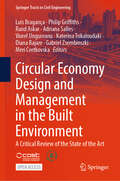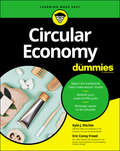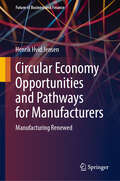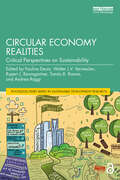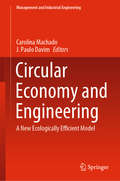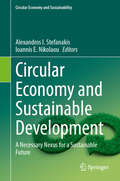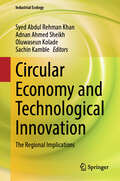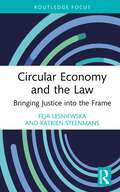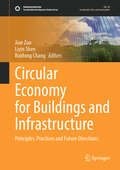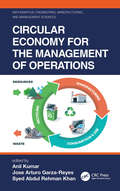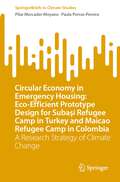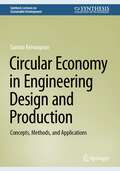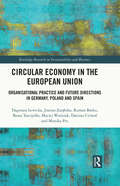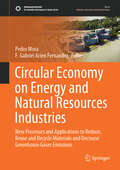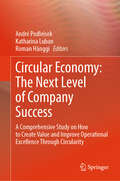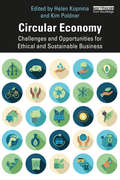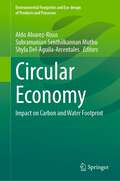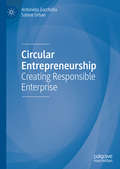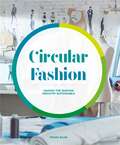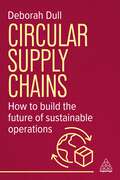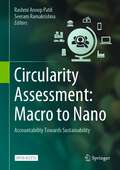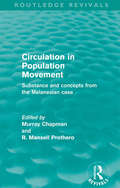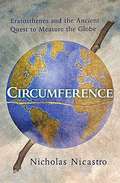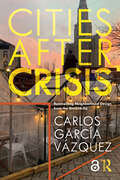- Table View
- List View
Circular Economy Design and Management in the Built Environment: A Critical Review of the State of the Art (Springer Tracts in Civil Engineering)
by Viorel Ungureanu Luís Bragança Meri Cvetkovska Rand Askar Philip Griffiths Adriana Salles Katerina Tsikaloudaki Diana Bajare Gabriel ZsembinszkiThis open access book offers a comprehensive exploration of Circular Economy Design and Management within the Built Environment, presenting a critical review of the current state of the art. Going through multi-level approaches from material usage to urban planning, it meticulously examines strategies for circular building design, criteria, and indicators for circularity. Additionally, it explores practical tools and frameworks, as well as roles and relationships of stakeholders along the entire value chain. Through insightful case studies and critical analysis, readers gain a deep understanding of circularity principles and applications, circularity management models and feedback systems, sustainable practices, and the integration of circularity into technological advancements and digital tools such as BIM. The importance of this book lies in addressing pressing challenges in contemporary architecture and construction, providing a roadmap for sustainable, circular solutions. It tackles the critical need to transition from linear to circular practices, emphasising resource efficiency, waste reduction, and the longevity of structures. By offering practical insights and highlighting successful implementations, the book aims to guide architects, civil engineers, designers, sustainability professionals, and policymakers towards informed decision-making in creating environmentally conscious built environments. Designed for these professionals and researchers, this book serves as a valuable resource for anyone passionate about reshaping the future of our built spaces with a focus on circularity and environmental responsibility.
Circular Economy For Dummies
by Eric Corey Freed RitchieImagine a future free from wasted materials, labor, and energy for you, your business, and your family A circular economy is an economic system designed to save money, eliminate waste, and achieve deep sustainability. No-brainer, right? Circular Economy For Dummies explains why the old way of doing things (the take-make-waste model of a linear economy) is fast going the way of the dinosaurs, and it gets you ready to think circular. From business processes and material lifecycles to circular design in just about every industry, this book is a fascinating glimpse into the sustainable future we urgently need. Whether you’re a designer looking to create better products, a manufacturer looking to streamline your operations, or simply looking to develop a healthy and sustainable lifestyle, this book shows you how. Learn how to innovate for a circular economy, how to turn trash into treasure, and how to calculate the (potentially large) amount of money this will save you. And—bonus—you'll feel good doing the right thing and being a part of our regenerative future! Challenge the assumptions behind the old-school "linear economy" model Learn how we can work together to achieve a waste-free future Save money by rethinking your resource use or business supply chain Reimagine households, neighborhoods, schools, companies, and societies The future is circular. Buck business-as-usual and learn how to create a circular economy for all!
Circular Economy Opportunities and Pathways for Manufacturers: Manufacturing Renewed (Future of Business and Finance)
by Henrik Hvid JensenIn today's rapidly evolving manufacturing landscape, the future competitiveness for manufacturers hinges on three interlinked paradigms: 1. Circular Economy Models for Zero-Waste Product Lifecycles: The shift from traditional linear models to circular ones is increasingly crucial. Circular strategies extend product lifecycles, optimize resource use, and open new revenue streams, ultimately bolstering resilience, competitiveness and customer relationships. 2. Sustainable Manufacturing Through Decarbonization: As global awareness around sustainability grows, the push toward decarbonized manufacturing processes is no longer optional. Such an approach minimizes environmental impact while aligning with international sustainability goals. 3. Digital Enablement for Paradigm Transformation: Digitization serves as the lynchpin in realizing cleaner manufacturing and circular economy objectives. Tools like the Digital Product Passport (DPP) empower manufacturers to achieve transparency, encourage collaboration, and create unmatched business value, expediting the transition to sustainable and circular manufacturing. One of the most pressing challenges for manufacturers today is achieving the transition to cleaner and circular business models in a financially viable way. This book delves deeply into the business opportunities circularity presents and the pivotal role of digital solutions in enabling a smooth and cost-effective transition. It emphasizes how digitization can address economic feasibility concerns while driving operational efficiency and sustainability. By breaking down these critical elements, the book provides actionable insights and frameworks, serving as a practical guide for manufacturers striving to align economic priorities with environmental and operational demands, ensuring long-term competitiveness and resilience. Visit https://circularpathwaysbook.com to continue your journey.
Circular Economy Realities: Critical Perspectives on Sustainability (Routledge/ISDRS Series in Sustainable Development Research)
by Andrea Raggi Pauline Deutz Vermeulen, Walter J.V. Rupert J. Baumgartner Tomás B. RamosThis book addresses the realities of the circular economy, a resource efficiency concept that has risen to global prominence in academic, policy and business circles over the last decade. Considered an approach to sustainable growth, the volume critically analyses how sustainable emerging applications of a circular economy are in practice.The book stems from an international, interdisciplinary project exploring the discourses, policies, implementation and impacts of the circular economy across public, private and third sector accounts. It draws on a wide range of case studies, from the UK, Portugal, Austria, Italy, the Netherlands, France, Chile, China, Nigeria, Taiwan and Vietnam, highlighting how experiences both shaped and were shaped by the places in which they were happening. It provides a guide to researching a complex phenomenon such as a circular economy, which involves both collaboration and competition between multiple stakeholders across different sectors and places. Synthesising the multiple perspectives employed in the project, the book makes recommendations for circular economy implementation in different contexts, including the assessment of sustainability implications, whilst indicating the limited potential for circular economy activity to bring social and economic benefits without explicit motivation for those to happen.Benefitting from extensive empirical research, this critical assessment of sustainability in the context of the circular economy will appeal to a broad readership of academics, upper-level students, practitioners and policy-makers in sustainable development, business, economics, geography, sociology and environmental engineering.The Open Access version of this book, available at http://www.taylorfrancis.com, has been made available under a Creative Commons Attribution-Non Commercial-No Derivatives (CC-BY-NC-ND) 4.0 license.
Circular Economy and Engineering: A New Ecologically Efficient Model (Management and Industrial Engineering)
by J. Paulo Davim Carolina MachadoThis book provides support to academics and researchers, as well as those operating in the management and engineering fields that need to deal with policies and strategies that allow to move towards a more sustainable paradigm, a greener economy that guarantees economic development and the improvement of living and working conditions. Drawing on the latest developments, ideas, research and best practice, this book examines the new advances in the subjects of circular economy.
Circular Economy and Sustainable Development: A Necessary Nexus for a Sustainable Future (Circular Economy and Sustainability)
by Alexandros I. Stefanakis Ioannis E. NikolaouThis book will highlight the role of CE in the sustainability field as it is expressed in the various fields and disciplines and its contribution to building a sustainable society by providing a better understanding of the relevant social and cultural structures and the need for cross-disciplinary knowledge and diverse skills. Such an integrated approach which combines the concept of sustainability in the engineering field to create a CE, has not yet been presented in detail in the published literature, and there are only scattered studies covering only small parts of this holistic approach. Hence, this book will represent a single reference that will provide summarized information and state-of-the-art knowledge on this topic of the future. The book will include chapters showcasing/investigating the relation between circular economy principles and their realization in different engineering fields. This includes theoretical justification, research studies and full-scale case studies. The approach focuses on two distinct levels: macro and micro, on both production and consumption sides.
Circular Economy and Technological Innovation: The Regional Implications (Industrial Ecology)
by Syed Abdul Rehman Khan Oluwaseun Kolade Sachin Kamble Adnan Ahmed SheikhThis book explores the circular economy, its context, methodology, and commercial strategies, with a focus on waste minimization, recycling, green marketing, and sustainable business practices to facilitate resource recovery. It considers IR 4.0 and 5.0 to show how smart technology innovation extends circular economy through industrial organizational sustainability and investigates circular economy technology innovation in multiple scenarios to exploit product re-usability and technological innovation in Asian, European, and Australian contexts. It discusses novel digital technologies such as blockchain, additive manufacturing, AI, ML, and IoT for global supply chain tracking. This book is valuable for instructors and students in business, environmental studies, supply chain management, product re-manufacturing, and marketing programs seeking cutting-edge Circular Economy and Technological Innovation trends.
Circular Economy and the Law: Bringing Justice into the Frame (Routledge Focus on Environment and Sustainability)
by Feja Lesniewska Katrien SteenmansThis book explores the role of law and policy in circular economy transitions and their impacts on justice, including on distributional equity and recognition and procedural rights, especially for people already marginalised under the current dominant economic system. Amid increasing demand for virgin raw materials, and unsustainable consumption and waste disposal that are driving the global ecological and climate crisis, there are growing calls to urgently transition to circular economies. Despite an increasing number of circular approaches being adopted, implemented, and integrated in national and local laws and policies, the number of commercially successful business stories remains isolated. Moreover, questions about whether circular economy laws and policies are delivering fair and just global outcomes need to be addressed. This book examines this significant knowledge gap to understand legal experiences, including justice and equity issues in the global context, so that these can inform wider design and implementation. The book begins by explaining the concept of a circular economy and its context within wider issues of sustainable development and justice. The first part of the book then examines the legal context of the circular economy by analysing legal forms in practice and those recommended in wider scholarship before considering how these could impact on existing inequity and injustices globally. The second part delivers an empirical understanding of the implications of the law on circular economy approaches and the global equity and justice dimensions through two case studies on solid waste management and forestry. The final part addresses legal opportunities and challenges for wider implementation of circular economy approaches that incorporate justice into its framing. This book will be of great interest to students, scholars, and practitioners of environmental and natural resource law and policy, circular economy, industrial ecology, natural resource management, and sustainable development more broadly.
Circular Economy for Buildings and Infrastructure: Principles, Practices and Future Directions (Sustainable Development Goals Series)
by Liyin Shen Jian Zuo Ruidong ChangThis edited volume covers theoretical and practical aspects of circular economy in building development, offering chapters dealing with topics such as material design, affordability of housing development, waste management and recycling, smart metering, and more. A particular focus is placed on various stakeholders’ points of view. The book's chapters are co-developed and contributed by multidisciplinary teams including both academics and industry practitioners. The case study-oriented approach taken here helps to facilitate the reader's understanding of how building sustainability can be achieved in the context of circular economy. The building industry has significant environmental, social and economic impacts. As one of the biggest energy consumers and carbon emitters, building sustainability has attracted wide attention globally. Building projects and their associated activities consume a large amount of energy, natural resources and water while producing a large proportion of wastes throughout their lifecycles. The traditional linear approach of “make, use and dispose” has been heavily criticized, whilst the circular approach has gained momentum. Indeed, circular economy has emerged as one of key principles to manage sustainability related issues by means of focusing on the circularity of resources as well as the cost implications.
Circular Economy for the Management of Operations (Mathematical Engineering, Manufacturing, and Management Sciences)
by Anil Kumar Syed Abdul Rehman Khan Jose Arturo Garza-ReyesCircular-Economy is a new concept in operations management. Its goal is to redefine growth, focusing on positive benefits arising for society as a whole out of efficiencies such as designing waste out the operations process. This book will help practitioners use the proper strategy for effective adoption of Circular practices to use in their organization. Features: Provides a complete understanding of Circular-Economy practices Offers advanced mathematical models to help industry management adopt the correct practices Presents a deep understanding of cross-functional and customer-focused design thinking Covers how to develop sustainable practices in all types of activities within operations management. Circular Economy for the Management of Operations will be of interest to practitioners and researchers in engineering as well as business management
Circular Economy in Emergency Housing: A Research Strategy of Climate Change (SpringerBriefs in Climate Studies)
by Pilar Mercader-Moyano Paula Porras-PereiraIn recent years, there has been an upsurge in the number of forced displacements due to natural disasters, armed conflicts, and pandemics, which has favoured an increase in the number of temporary accommodations. Although the provision of shelter after an emergency situation is one of the priorities of humanitarian aid, the reality is that the conditions in which people live in a situation of forced displacement are absolutely precarious and overcrowded. Nowadays, this type of housing tends to have a short lifespan, deepening the environmental impact and the generation of waste. Likewise, added to this great problem is the linear economic system implemented worldwide, which also causes a high rate of waste.This investigation develops an eco-efficient design protocol that determines the basic premises in any emergency situation, therefore avoiding the precarious nature to which those in forced displacement are exposed. Moreover, the research investigates different constructive solutions that can respond to situations of natural catastrophes or humanitarian disasters where emergency housing is needed as well as the possible alternatives from the point of view of circular economy. Eco-efficient and environmentally correct solutions are sought, which can be adaptable to the different scenarios where emergency housing may be needed, thus creating a rapid, easy, functional, and environmentally correct architecture, adaptable to these types of situations. The study shows that the factors that characterize emergency architecture can be an example of where the issues around the sustainability factor are applied in a practical way. The main objectives of this study are to develop an eco-efficient design protocol which determines the basic premises in any emergency situation and to find eco-efficient and environmentally correct solutions, adaptable to different scenarios, which have similar climatic characteristics, and where emergency housing may be needed, thus creating a type of ephemeral architecture but sensitive to the user to whom it is intended and in accordance with the optimal conditions of habitability.
Circular Economy in Engineering Design and Production: Concepts, Methods, and Applications (Synthesis Lectures on Sustainable Development)
by Samira KeivanpourThis concise text provides the concepts, methods, and application examples for integrating sustainability into engineering design and production. It discusses the role of sustainability in the value creation processes of various enterprises and different tools and methods for systematic incorporation of social and environmental aspects into the product's life cycle. The following topics are covered: sustainable development in engineering systems and the life cycle concept, norms and standards in the sustainable development and integration of socio-economic assessment into technical valuation, production systems, management of the production systems based on circular economy principles, ecodesign practices, and value creation and innovative design in the circular economy. Provides a concise guide for engineering students for applying circular economy practicesPresents examples and short case studies for understanding the methods and toolsFacilitates understanding and application of the life cycle perspective in product manufacturing and green engineering
Circular Economy in the European Union: Organisational Practice and Future Directions in Germany, Poland and Spain (Routledge Research in Sustainability and Business)
by Dagmara Lewicka Joanna Zarębska Roman Batko Beata Tarczydło Maciej Wożniak Dariusz Cichoń Monika PecCircular Economy in the European Union: Organisational Practice and Future Directions in Germany, Poland and Spain presents the EU's journey towards a Circular Economy (CE), identifying significant organizational practices in this gradually adopted field among member countries. The book also aims to develop and propose innovative initiatives and practices for implementing CE across various economic sectors in selected EU countries, such as Poland, Spain and Germany. Covering topics which include the implementation of CE in the EU and worldwide, green employee behaviors, corporate social responsibility in creating pro-environmental attitudes and models of eco-digital factory transformation in SMEs, the book emphasizes the importance of innovative, environmentally friendly, low-waste, and low-emission technologies. Consisting of thirteen interconnected chapters, it discusses the challenges and opportunities of CE, the importance of business engagement in addressing social and environmental problems, and provides practical examples of innovative solutions in various sectors. This volume will be of great interest to students and scholars of circular economy, corporate governance, business ethics and sustainable business, as well as entrepreneurs, managers, government representatives, and non-governmental organizations active in CE.
Circular Economy on Energy and Natural Resources Industries: New Processes and Applications to Reduce, Reuse and Recycle Materials and Decrease Greenhouse Gases Emissions (Sustainable Development Goals Series)
by Pedro Mora F. Gabriel Acien FernandezThis book masterfully bridges the gap between science and industry, offering readers invaluable insights into the technological advancements shaping our world. Amidst a profound industrial transformation aimed at minimizing environmental impact, this work highlights the pivotal role of reducing energy consumption and material waste. It aligns closely with the United Nations Sustainable Development Goals, encapsulating the global ambition for the coming years. The narrative delves into myriad examples of industrial evolution, showcasing how various sectors, especially energy (including electricity and oil & gas) and natural resource exploitation, are revolutionizing their processes to lessen their environmental footprint. Furthermore, each chapter of the book equips readers with the knowledge to spearhead innovative solutions tailored to these evolving processes, making it an essential resource for anyone committed to driving sustainable industrial advancements.
Circular Economy: A Comprehensive Study on How to Create Value and Improve Operational Excellence Through Circularity
by Roman Hänggi Katharina Luban André PodleisekWithout any doubt, the current prevailing Linear Economy principle of take-make-dispose is inherently unsustainable: Raw materials are extracted, transformed into products, and discarded as waste after use. The resulting environmental and economic challenges brought together both practitioners and academics to develop more sustainable methods for production and consumption. Especially the concept of Circular Economy has received a lot of attention. But despite many technical solutions, a key question for practical implementation has remained unanswered until now: How can enterprises integrate Circular Economy into their business strategy to leverage success? This book examines the topic of Circular Economy in an entrepreneurial context. It describes ten options for companies to retain value and identifies drivers and enablers for implementing Circular Economy in businesses. A survey among more than 500 industry experts revealed the extent to which retention options were implemented in practice. For the first time, relevant drivers and enablers for each retention option were identified. On top of this, case studies of successful circular market offerings shed light on each retention option in detail. The knowledge gained from research and the further shared experiences of experts that contributed to this book result in a 6-step management model. This model provides guidance on how to implement Circular Economy in organisations as an element of operational excellence and as a source of product, service, and business innovation. Now, every enterprise can start the journey. As the survey and the cases show: Circular Economy is a promising way to the next level of company success. The book at hand will help organisations to develop their own individual approach that matches their business model. In short, you will find: First comprehensive analysis of 10 retention options, their drivers, and enablers. Survey of more than 500 companies and in-depth case studies for each retention option. Practical research-based implementation model for companies.
Circular Economy: Challenges and Opportunities for Ethical and Sustainable Business
by Helen Kopnina; Kim PoldnerHow can we design circular business models? How can we organize the transition from a linear to a circular economy? And how can we imagine circular futures that help us transform current realities? This book aims to provide answers to these questions while addressing the challenges and opportunities of the circular economy. The authors reflect on why conventional sustainability models – such as the ‘triple P’ (People, Profit and Planet) or eco-efficiency – have failed in addressing environmental challenges, including climate change, biodiversity loss and pollution. They then move on to explore innovative circular business models, which propose to eliminate environmental damage by radically reforming the system of industrial production. Organizing the transition is a collaborative effort: entrepreneurs, consumers, policymakers, multinationals and intermediaries need to work together to foster the emergence of the circular economy as an institutional field. Together with younger generations of learners and equipped with beyond-human-centred values towards awareness of the material and natural world, novel circular futures can be imagined. Offering points of reference for continued critical discourse and examples of practically applicable sustainability solutions, this book will be of great interest to students, teachers, practitioners and scholars of circular economy.
Circular Economy: Impact on Carbon and Water Footprint (Environmental Footprints and Eco-design of Products and Processes)
by Subramanian Senthilkannan Muthu Aldo Alvarez-Risco Shyla Del-Aguila-ArcentalesThis book highlights ways to evaluate circular economy using global standard and footprints the way global firms are using to ensure the measurement of the impact. It presents various case studies from different sectors with the efforts made to contribute to circular economy and at the same time its contribution to minimize carbon and water footprints.
Circular Entrepreneurship: Creating Responsible Enterprise
by Antonella Zucchella Sabine UrbanThis original book explores how the principles of circularity, considered a law of nature but neglected within the materialistic orientation of the industrial age, are becoming attractive again in business and society. Investigation reveals enterprises small and large delivering a stimulating message, from changes in entrepreneurial mindsets to the inclusive use of new technologies and a push for innovation. Zucchella and Urban explore the novel concept of circular enterprise, showing how, with their capacity to innovate, these firms are becoming the most powerful actors of a new, sustainable social order. They examine two fundamental questions: why is this revolution occurring now, and how is it being implemented? Focusing on the most innovative practices, they demonstrate the potential of circular enterprise for industry and wider society, making clear that a new world is emerging.
Circular Fashion: Making the Fashion Industry Sustainable
by Peggy BlumCreating sustainable fashion has never been more important. Circular Fashion provides an accessible, practical, and holistic approach to this key topic for anyone studying fashion.This introductory text to sustainability in fashion includes best practice case studies and profiles of key companies such as Patagonia, Veja, Christopher Raeburn, and Stella McCartney. It begins with an overview of the fashion business, tackling the issues of the linear production model of make, use, dispose, before introducing the idea of the circular supply chain.Circular Fashion is the must-have book for fashion students, creatives and anyone passionate about sustainability and fashion.
Circular Fashion: Making the Fashion Industry Sustainable
by Peggy BlumCreating sustainable fashion has never been more important. Circular Fashion provides an accessible, practical, and holistic approach to this key topic for anyone studying fashion.This introductory text to sustainability in fashion includes best practice case studies and profiles of key companies such as Patagonia, Veja, Christopher Raeburn, and Stella McCartney. It begins with an overview of the fashion business, tackling the issues of the linear production model of make, use, dispose, before introducing the idea of the circular supply chain.Circular Fashion is the must-have book for fashion students, creatives and anyone passionate about sustainability and fashion.
Circular Supply Chains: How to Build the Future of Sustainable Operations
by Deborah DullAs supply chain operations continue to be recognized as critical to the transition to a circular economy, this practical resource provides an actionable outline for supply chain professionals wanting to implement a circular supply chain.The circular economy remains a common topic among supply chain professionals, especially in light of material disruptions, climate change pressures and the need to innovate on revenue models. Circular Supply Chains provides a bold vision of sustainability for supply chain designers, decision makers and operators to rally around. It will also, critically, provide a practical path on how to get from today's operations to the future of sustainable supply chains.Exploring topics like new digital technologies and the future of local supply chains, the book takes a practical approach including how-to checklists and circular supply chain examples. The book itself paints a vision and breaks theories down into reasonable, practical steps with concepts like repair demand sensing, supply planning, radical transparency and regenerative operations. This is an essential book for supply chain professionals keen to learn about how to transition to circular operations.
Circularity Assessment: Accountability Towards Sustainability
by Seeram Ramakrishna Rashmi Anoop PatilThis open access book attempts to provide a perspective on the circularity assessment at different levels of the systemic hierarchy and advocates better resource management for a sustainable future. It demonstrates how relevant circularity indicators are used for quantifying the extent of circularity of each level. Illustrative case studies that discuss the process of quantitatively interpreting progress towards circularity are provided. This work caters to a broad readership inclusive of governance, basic research, engineering, and business stakeholders. The conclusion signifies the role of consumer community in achieving circularity.
Circulation in Population Movement: Substance and concepts from the Melanesian case (Routledge Revivals)
by Murray Chapmna and R. Mansell ProtheroFirst published in 1985, this collection of essays deals with processes of population movement and how they have operated over time. It is also about people: Melanesian’s who number some five million and inhabit the region stretching from the Indonesian province of Irian Jaya to the Independent State of Fiji. Standard work on Movement in third world societies has emphasized migration, involving a shift in residence from one domicile to another, at the expense of the interchange of people between diverse places and different circumstances. Many moves, as from villages and towns, are circulatory: they begin at, go away from, but ultimately end in the same dwelling place and community. This book focuses on the full range of territorial mobility, especially circulation, and its meanings for the people involved. This volume brings together indigenous scholars, foreign field researchers, and international authorities from many of the social sciences: anthropology, demography, economics, geography and sociology. It presents a set of multicultural statements about the mobility of particular peoples within a region of the third world. This collection about specifically Melanesian issues aims to stimulate broader visions among population scholars, and it underlines the pressing need for more theoretical and empirical work on a volatile, yet neglected, category of population movement.
Circumference: Eratosthenes and the Ancient Quest to Measure the Globe
by Nicholas NicastroHow do you measure the size of the planet you're standing on? "Circumference" is the story of what happened when one man asked himself that very question. Nicholas Nicastro brings to life one of history's greatest experiments when an ancient Greek named Eratosthenes first accurately determined the distance around the spherical earth. In this fascinating narrative history, Nicastro takes a look at a deceptively simple but stunning achievement made by one man, millennia ago, with only the simplest of materials at his disposal. How was he able to measure the land at a time when distance was more a matter of a shrug and a guess at the time spent on a donkey's back? How could he be so confident in the assumptions that underlay his calculations: that the earth was round and the sun so far away that its rays struck the ground in parallel lines? Was it luck or pure scientific genius? Nicastro brings readers on a trip into a long-vanished world that prefigured modernity in many ways, where neither Eratosthenes' reputation, nor the validity of his method, nor his leadership of the Great Library of Alexandria were enough to convince all his contemporaries about the dimensions of the earth. Eratosthenes' results were debated for centuries until he was ultimately vindicated almost 2000 years later, during the great voyages of exploration. "Circumference" is a compelling scientific detective story that transports readers back to a time when humans had no idea how big their world was--and the fate of a man who dared to measure the incomprehensible. [This text is listed as an example that meets Common Core Standards in English language arts in grades 9-10 at http://www.corestandards.org.]
Cities After Crisis: Reinventing Neighborhood Design from the Ground-Up
by Carlos Garcia VazquezCities After Crisis shows how urbanism and urban design is redefining cities after the global health, economic, and environmental crises of the past decades. The book details how these crises have led to a new urban vision—from avantgarde modern design to an artisan aesthetic that calls for simplicity and the everyday, from the sustainable development paradigm to a resilient vision that defends de-growth and the re-wilding of cities, from a homogenizing globalism to a new localism that values what is distinctive and nearby, from the privatization of the public realm to the commoning and self-governance of urban resources, and from top-down to bottom-up processes based on the engagement and empowerment of communities. Through examples from cities around the world and a detailed look at the London neighbourhood of Dalston, the book shows designers and planners how to incorporate residents into the decision-making process, design inclusive public spaces that can be permanently reconfigured, reimagine obsolete spaces to accommodate radically contemporary uses, and build gardens designed and maintained by the community, among other projects.
